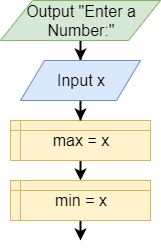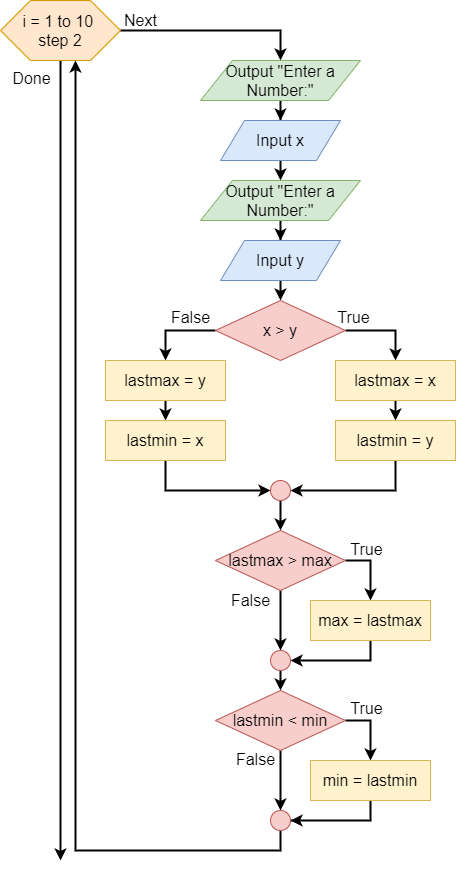Max and Min - Pairs
Another solution consists of comparing the numbers in pairs, instead of one at a time.
Base Case
When we have received just one number, this number is both the maximum and the minimum. In the initial state, you have max holding the maximum, and min holding the minimum. The invariant is the following:
- The variable
maxholds the maximum of all the numbers considered so far - The variable
minholds the minimum of all the numbers considered so far
The algorithm is depicted by the following flowchart and pseudocode:
print "Enter a Number:"
input X
MAX = X
MIN = XThe Next Two Numbers
In this program, instead of just considering one number at a time, we’ll ask the user to input two numbers. Then, we can determine which of those two inputs is larger (we’ll call it lastmax), and compare it to the value in max. Similarly, we can do the same for the smaller value (called lastmin) and min. Would this program be more efficient?
The algorithm is depicted by the following flowchart and pseudocode:
loop I from 1 to 10 step by 2:
output "Enter a Number:"
input X
output "Enter a Number:"
input Y
if X > Y
LASTMAX = X
LASTMIN = Y
else
LASTMAX = Y
LASTMIN = X
end if
if LASTMAX > MAX
MAX = LASTMAX
end if
if LASTMIN < MIN
MIN = LASTMIN
end if
end loopOnce again, we can easily show that the same loop preconditions, postconditions, and invariants work for this loop:
- Loop preconditions:
- The variable
maxholds the maximum value among all the numbers considered so far - The variable
minholds the minimum value among all the numbers considered so far - The new inputs considered are a number
- The variable
- Loop postconditions:
- The variable
maxholds the maximum value among all the numbers considered so far - The variable
minholds the minimum value among all the numbers considered so far
- The variable
- Loop invariant:
- The variable
maxholds the maximum value among all the numbers considered so far - The variable
minholds the minimum value among all the numbers considered so far
- The variable
A full flowchart of this program can be found by clicking the following link:
It is helpful to have this diagram available in a second browser tab for review on the next few pages.

